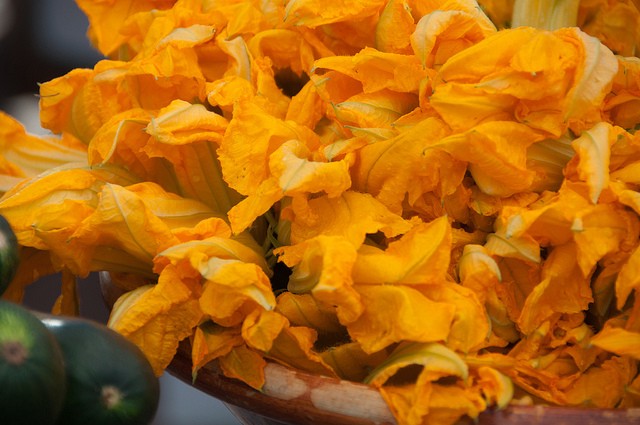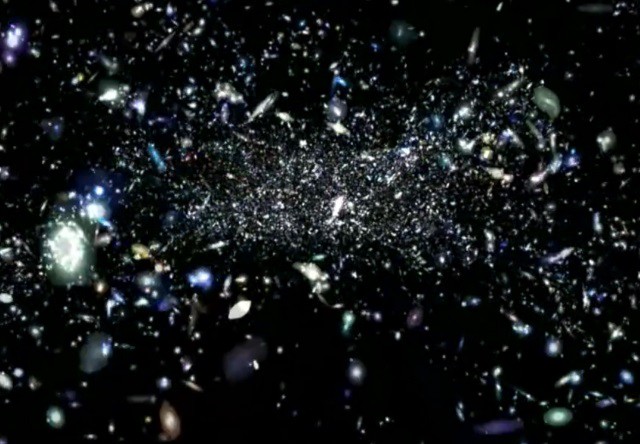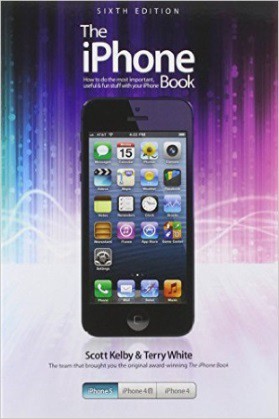Eat the Squash Blossom

I don’t cook with flowers much; I tend to find them either very bland (pansy, carnation) or too delicate to use as anything but a carefully placed garnishes (nasturtium, herb flowers like basil). But squash blossoms are a bit different. They’re easy to find during the summer and fall in farmers markets, they’re hardier and more flavorful than most flowers, and because they’re essentially a byproduct, they fit in nicely with my refrain of Use The Whole Plant.
Blossoms, or flowers, are the reproductive organs of plants, haha, gross. All fruits begin with flowers, though not all flowers become fruits. The basics: A flower is fertilized, which triggers the formation of a fruit, which is designed to be delicious and full of seeds so animals will eat the fruits and shit out the seeds somewhere else, thus allowing the plant to produce offspring. Many plants are capable of having sex with themselves in order to fertilize their flowers, but some plants have a harder time doing that than others.
There are a few different categories of flowers, relating to their gender. Monoecious plants have both male and female flowers on the same plant, which means it can fertilize itself. Dioecious plants have only one gender, male or female, and female plants must be fertilized by a separate male plant.
Within the monoecious category, we have a botanical difference between “perfect” and “imperfect” flowers. Perfect flowers have both male and female parts within the same flower; tomatoes and peppers are both perfect plants, botanically. This is one reason why tomatoes and peppers are very good choices for tiny shitty urban gardens; you don’t need to worry about pollination or, really, anything but sunlight and water. In both tomatoes and peppers, the fruit thrusts right through the center of the flower.
Squash is monoecious but imperfect, meaning it produces male flowers and female flowers, and while the plant can fertilize itself, that process still needs some external help. In many cases that’ll happen naturally thanks to bees or other small critters; if it doesn’t you can do it yourself with a Q-tip, though let me tell you, fertilizing a squash plant with a Q-tip feels VERY odd. Regardless, it is only the female plants that will actually bear fruit in squash plants. In squash (and, for example, in pears), the bit of the plant that will become the fruit is actually the stem just underneath the flower. That part of the stem will swell most grotesquely, leaving the female flower attached until it eventually falls off.*
So that’s how squash is made. But that leaves an awful lot of male flowers sitting on the vine. Squash plants produce many more male blossoms than female, and as with all males, the male blossoms are of limited use — a single male blossom can fertilize many female blossoms. The smarter cuisines around the world have figured out that the male squash blossoms can be safely picked without unnecessarily damaging the reproductive capabilities of the squash, and have further figured out that the squash blossom is exceedingly tasty. Because squash blossoms are generally rescued garbage, you should never pay very much for them: I know they’re flowers, but they’re not luxury items. Farmers markets tend to sell a container of twenty or twenty-five blossoms for about five bucks, which is a fine price.
Squash blossoms can come from most any kind of squash. During the summer, you’ll mostly see the ones from summer squash varieties like zucchini, and during the early fall you’ll see some from hardier squash like butternut and even pumpkin. (Pumpkin blossoms look basically the same as zucchini blossoms, maybe a little bigger.)
Unfortunately there is one very dominant recipe for cooking squash blossoms. Most people simply stuff it with cheese, batter it, and deep-fry it. There’s nothing really wrong with that recipe; I would never look down my nose at something that’s stuffed with cheese and fried. But that strategy treats the squash blossom as if its only attribute is its easily-stuffable shape; it assumes a squash blossom is nothing more than, like, a wonton wrapper. And that’s rude, because the squash blossom is a surprisingly flavorful ingredient — like very young, very fresh zucchini, with a distinct floral sweetness.
They can be eaten raw or cooked, though my favorite uses of the blossom are either raw or very minimally cooked, because I think that’s the best way to retain its flavor. Most recipes will tell you to prepare the squash in finicky ways, tearing off what remains of the stem, picking off the little leaves around the outside of the flower, and even digging your fingernails inside the blossom itself to pick out the pistil. These are all completely unnecessary steps. The entire thing is edible and there’s no need to prepare it at all.
Squash blossoms, like summer squash, have a subtle, versatile flavor, and can be used in basically any cuisine. They’re extremely common in Mexico, where they’re the star of my favorite quesadilla (squash blossoms, chiles, the Oaxacan string cheese called quesillo), and are used liberally in Italy and Greece. But there’s nothing stopping you from inserting them into Thai or Vietnamese or Spanish or Lebanese recipes; like tofu, they’ll take to pretty much any combination of flavors. Here are some of my favorites.

Squash Blossom Quesadilla
Shopping list: Large flour tortilla, squash blossoms, Oaxacan string cheese (if you can’t find it, mozzarella works very well), poblano peppers, epazote or cilantro
Put a dry cast iron pan (or a comal, the Mexican equivalent made of clay, but, like, if you have a comal there’s no way you need me to tell you how to make this quesadilla) over medium-high heat and let it get real hot. Put two whole poblano peppers on the pan and dry-roast for about a minute on each side until the skin is burnt and blackened. When thoroughly burnt, throw the peppers into a ziploc bag and seal. Wait about ten minutes for the moisture inside the pepper to do its work, then take out. The the stem should pull out with no effort, and you should be able to rub off the skins (under running water, if you’d like) with your thumbs. Discard the seeds as well, and slice into strips.
In the same cast iron pan, now over medium heat, place a tortilla. Quickly scatter some cheese on the entire tortilla. On one half of the cheese-covered tortilla, place peppers and about four squash blossoms, roughly torn if you want (I usually don’t), as well as a scattering of chopped cilantro or epazote. When the cheese is melted, fold the half of the tortilla with just cheese onto the half with all the other stuff, and press with a spatula. Flip a couple times, and when the tortilla has a few splotches of brown and is all toasty, take it out and slice into a few pieces. Serve with salsa if you want.
Pasta With Mushrooms And Squash Blossoms
Shopping list: Pasta of your choice (I like pappardelle for this), squash blossoms, maitake mushrooms, leeks, butter, parsley, basil, pecorino cheese, an egg, olive oil
A variation on this recipe, changed only slightly because it’s very good. First, cook some pasta. Don’t overcook it; we’ll be finishing the pasta in the pan, so undercooked is better than over.
Clean and slice the leeks finely and break the maitake — sometimes called hen-of-the-woods — mushrooms into pieces about the size of your thumb. (You can use other mushrooms if you want, but I like their firm texture and intense umami flavor.) In a heavy pot (enameled cast iron would be good for this) over medium-low heat, throw in about a tablespoon of butter and let it melt. Throw in the leeks, stir for a minute or two, then throw in the mushrooms. The thing about mushrooms is that you have to cook them for a lot longer than people think; for maitakes, you want them to be kind of crispy and browned.
Poach an egg. I don’t have any special strategy for this; I don’t add vinegar or use any cool tools, I just put a pot of water on the stove and crack an egg into it and then at some point take the egg out. Chop the herbs finely.
Once the mushrooms are cooked, get ready to do everything else all at once. Turn the heat up a bit, to medium. Throw in a handful of squash blossoms and stir quickly for about a minute, just to warm them up and get a little coating of butter on them. (If there’s no more butter in the pan, add more.) Then throw in the pasta and stir constantly to make sure it doesn’t stick. You want everything all mixed up. After a minute or two, season to taste with salt and pepper.
Pour this all onto a plate, top with the poached egg, and shave a whole bunch of pecorino over the top. Maybe a little more salt and pepper.
Squash Stir-Fry
Shopping list: Summer squash, squash blossoms, rice, soy sauce, mirin, ginger, rice wine vinegar, sugar, garlic, scallions, Thai bird’s eye chile pepper, peanut oil, roasted peanuts (no salt, ideally)
Cook rice — whatever kind you you want, using whatever method you want.
Chop the garlic, scallions, chile, and, if using, fresh ginger. (If using frozen ginger, which, by the way, good strat, hold off for a sec.) Put a wok on the stove over low heat, add a tablespoon or so of peanut oil and let it heat up for a minute. Throw in the garlic, scallions, chile, and maybe ginger and stir; let cook until the whites of the scallions are translucent. Throw in a handful of peanuts and stir.
Mix up your sauce: soy, mirin, sugar, rice wine vinegar, and, if you’re using it, frozen ginger grated on a microplane. Adjust it: you don’t want it to be too salty, too sweet, or too sour.
Cut summer squash into smallish cubes. Turn the wok’s heat up to high and throw in the squash. Stir constantly for a few minutes to fry up the squash. Pour in the sauce and stir, then let it reduce for a minute or two. While it reduces, roughly tear a whole mess of squash blossoms and, right before you’re ready to cook, throw them in, give a quick stir, and season with salt (if needed; it may not need any). Don’t let the squash blossoms stay on the heat for more than a minute. Serve over rice.

That’s really a basic couple of recipes to kind of show what squash blossoms can do. There are many more; try topping your frittata, quiche, or (egg/potato-type) tortilla with whole blossoms before baking! Put them on a pizza! Stir-fry them with fish sauce and lime juice and serve with cilantro rice! They’re almost as versatile as summer squash, which is probably the most versatile vegetable I can think of; they work with spice, with cheese, with egg, with salt and herb and bread. Eat the blossom! Even if you don’t stuff and fry it.
*Correction: Dan was incorrect about some of his horticulture. He apologizes for the error and thanks brilliantmistake for correcting him in a much nicer tone than he possibly deserves.
Photo by Paul Asman and Jill Lenoble
The Universe Is Dying And I Don't Feel So Good Myself

What’s going on in the world? “Just as we become less active in our old age, the same is happening with the Universe, and it’s well past its prime. It will just grow old forever, slowly converting less and less mass into energy as billions of years pass by, until eventually it will become a cold, dark, and desolate place where all of the lights go out,” says Dr. Luke Davies of the International Centre for Radio Astronomy Research.
“The Universe has basically plonked itself down on the sofa, pulled up a blanket and is about to nod off for an eternal doze,” agrees Professor Simon Driver of the same organization.
That’s right: The Universe is running out the clock. But what does it mean for you?
There is good news and bad news. The good news is that nothing you do matters. This is difficult to remember as you bounce around the cosmos, buffeted about by an endless series of emotions that all feel as if they are entirely irrevocable while you’re experiencing them. Lust, hate, fear, greed, want, joy, sorrow, guilt: You run the gamut every day and each one seems so vital and all-encompassing that when you’ve cycled through to the next you’ve forgotten just how temporary the last one turned out to be. Well, it’s all temporary. Everything is. Every victory, every defeat, every choice made or decision deferred adds up to nothing. You feel pain for a certain amount of time — or happiness, or wonder, or bliss, but more likely pain — and then it’s over. The universe makes no value judgment because the value of everything is zero and the concept of judgment is meaningless. It’s just a bunch of stuff that happened, and when it ends it’s gone and it is as if none of it registered. You did not even leave a dot on the vast canvas of existence, and now that canvas itself has stopped adding dots of its own. Everything is nothing.
The bad news is there’s another few billion years of this nonsense to get through.
Anyway, there is video:
Hope that helps. But even if it doesn’t, what difference does it make? That’s right, none. NOTHING DOES OR DID OR EVER WILL. Feel better now? You’re welcome.
I Was Told Rich People Would Be Cake
“Look around at the charitable causes favored among today’s info-elite, and you’ll see the public good packaged as one continual study in billionaire self-portraiture. The Bill and Melinda Gates Foundation, endowed by a celebrated prep-school graduate and Harvard dropout, devotes the bulk of its endowment and nearly all of its intellectual firepower to laying waste to the nation’s teachers’ unions. The Eli and Edythe Broad Foundation is but the Gates operation on steroids, unleashing a shakedown syndicate of overcapitalized and chronically underperforming charter schools in the beleaguered urban centers where the democratic ideal of the common school once flourished. The Clinton Global Initiative, when it’s not furnishing vaguely agreeable alibis for Bill Clinton’s louche traveling companions, is consumed by neoliberal delusions of revolutionary moral self-improvement via the most unlikely of means — the proliferation of the very same sort of dubious financial instruments that touched off the 2008 economic meltdown. In this best of all possible investors’ worlds, swashbuckling info-moralists will teach international sex workers about the folly of their life choices by setting them up with a laptop and an extended tutorial on the genius of microloans.”
— More like NOblesse oblige, right? Ugh, sorry. Anyway, Awl pal Chris Lehmann does his thing.
COMA, "Lora"
It’s going to rain all day, and that’s okay. What difference does it make what the weather does? It’s dark out or light, it’s wet or it’s dry, it’s hot or it’s cold, in the end we all die. This new track from Coma should serve as a decent distraction while the water pours down, at least. Enjoy.
New York City, August 9, 2015

★★★★ Clouds were missing at first, then arrived in flaring white on the clear air. The notebook page was blinding, the shadow of the moving hand edged with a flickering green laser, till a cloud intervened. The balloon the eight-year-old had gotten from the kids’ haircut place feinted toward the heads of the sidewalk lunch crowd on Amsterdam. A spot of yellow shone on the ground below it. It was just hot enough for the boys to complain about the 14-block walk, and not near hot enough to take the complaints seriously. By the 72nd Street subway, another gust of breeze sent the balloon on a fatal lurch into the burning end of a stranger’s cigarette. In the afternoon, the playground fountain was on, though no one really needed cooling off. Squishy footfalls sounded as children ran from the spray over onto the climber, leaving a soggiest-common-denominator trail of water across the padding and equipment. The splash from a smaller child’s shoes was strong enough to hit bystanding ankles. The sharp light disclosed irregularities in the three-year-old’s haircut, the fresh straight-line marks of each snipped fingerfull of hair making a little tonsorial Sydney Opera House. The clouds after sunset were dramatic and smoky.
Joanna Newsom, Yes You Can
by The Hairpin
Some of my favorite things are twee. I love Belle and Sebastian. I love the Free Design. I even like the Ladybug Transistor, and the movie Submarine. Oh, and I LOVE Miranda July. I totally love Miranda July. I even liked the movie with the talking cat, and even the part of the movie where the guy talks to the moon about his relationship woes, and by the end I even liked the talking cat itself. Why? Because it worked! Everything made sense relative to everything else. (You and Me and Everyone We Know was a little much.) Oh, and my favorite instrument is the flute. Sometimes twee is just the medium. For example, Joanna Newsom.
Are Screens Making Books So Boring That Kids Won't Bother To Read Them?

“I remember reading novels because the life within them was more exciting, the characters more attractive, the freedom more exhilarating than anything in the reality around me, which seemed stultifying, parochial and enclosed. To a kid reading Pynchon on a Galaxy 6 this summer, it has to compete with Snapchat and Tinder, plus movies, games and music…. Life itself has become more immersive.”
— I have been thinking about this a lot lately. You hear all the stories of kids not wanting to learn to drive because they no longer need to physically travel somewhere to get separation; friends and communities and other worlds altogether are all on the phones they carry with them like an extra appendage. These stories are almost certainly exaggerated, but they speak to a larger concern that our surfeit of virtual opportunity and diversion will drain our youth of the greatest incentive for self-improvement there is: the desire to get away from parents and the general boredom of typical teenage subsistence. What do you do when you don’t have “there’s nothing to do” as an animating principle? What is life like when ennui and the angst of repeating the same eventless existence every day aren’t all that’s available? Without those things, what will happen to our kids? They will be eaten by robots, that’s what. I’m telling you, everything is a scam set up by the robots so that eventually they can eat us. You laugh at me now but when those terrible metal teeth are clamping down on the bodies of everyone you hold dear you’ll wish you had listened to me. You fools.
The Internet Of Things That Will Kill You
“It may be hard to fix security on the digital Internet, but the Internet of Things should not be built on this faulty foundation. Responding to digital threats by patching only exposed vulnerabilities is giving just aspirin to a very ill patient. It isn’t hopeless. We can make programs more reliable and databases more secure. Critical functions on Internet-connected objects should be isolated and external audits mandated to catch problems early. But this will require an initial investment to forestall future problems — the exact opposite of the current corporate impulse. It also may be that not everything needs to be networked, and that the trade-off in vulnerability isn’t worth it.”
— Hahaha, doesn’t this lady realize that if we’re able to, we’re going to, especially if we can charge extra and jack up ludicrous valuations by using the amazing buzzwords of the day — you know, the ones that seem to work as talismans to ward off critical thinking? If we don’t wire up every single thing in the world how are we going to empower the robots that will wind up eating us? And make no mistake, we will be eaten by robots. It’s just the way things are going to play out. “Not everything needs to be networked.” Go back to the Stone Age, you tech-hating weirdo!
The Hidden Sadness Of Britain's Children
Isn’t it weird how Britain’s neglected children sound so much classier and more refined than American kids who have been orphaned by smartphones and other mobile gadgets? I bet it’s the accents. Anyway, if they started shooting Seven Up! today it would look like this, and the second installment would show a bunch of 14-year-olds either running from fires or being eaten by robots. Because there’s no future. [Via]
"Bach gives us the sensation of the joy of life, the joy of movement."
“There are countless transcriptions of this piece — each worse than the next — for string trio, string orchestra, brass quintet, etc. It is understandable that all instrumentalists would like to play this unique masterpiece, but that doesn’t give them the licence to change Bach’s typically keyboard-inspired writing to suit the requirements of their own instruments. This is not an ensemble piece, it is for a single instrument, and for one player alone. That fact is fundamental.”
— András Schiff, whose 2012 release of Bach’s Well-Tempered Clavier
may well be the definitive recording of that work, discusses Goldberg Variations, which I have heard certain people describe as the greatest work of music ever composed. I personally enjoy some of the transcriptions but I can understand his impatience with them.
